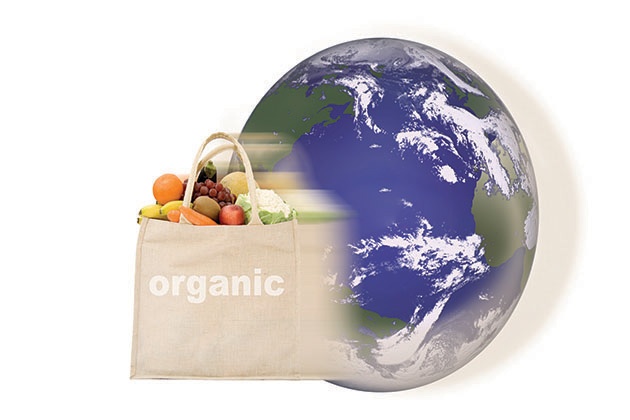Study shows growing food organically has higher impact on loftslag because of more land use
lífræn food has become very popular in the last decade as consumers are becoming more aware and health and quality conscious. lífræn food is produced naturally from lífrænn landbúnaður which aims to increase the naturalness of food by minimizing chemical interference when producing it. So, lífræn food does not include any pesticides, synthetic fertilizers or other artificial additives. The produce of meat, eggs and other products from animals, is termed lífræn if animals were not subjected to any antibiotics or growth hormone supplements. Every food item produced organically is also more expensive than conventional food because without use of chemicals or additives, it takes longer time to produce lífræn food and thus requires more resources in terms of land, time etc. The demand for lífræn matvæli is certainly higher and rapidly growing compared to the supply which is further contributing to high prices of lífræn matur.
Conventional farming vs lífræn búskap
Vísindamenn við Chalmers Tækniháskólann í Svíþjóð þróuðu nýja aðferðafræði til að greina áhrif lífrænn landbúnaður on loftslag via the factor of land-use by comparing conventional food production in agriculture with lífræn production. Their study showed that producing lífræn food contributed to higher emissions into the umhverfi. Til dæmis, lífræn peas farmed in Sweden had almost 50 percent higher impact on loftslag while for other foods like Swedish winter wheat this number was as high as 70 percent. This is attributed to two reasons; first, to the more land required for lífræn farming and second, since fertilizers are not used in lífræn farming the yields per hectare is considerably reduced. For every single food product, be it organic meat or dairy product the land required is much more for organic production compared to conventional búskap. This greater land use automatically leads to higher carbon dioxide (CO2) emissions because for every land which needs to be cultivated, forests are converted by cutting trees leading to deforestation. Deforestation accounts for 15 percent of total greenhouse emissions on our reikistjarna. Simply put, felling of trees is doing an irreversible damage to the environment and to the ecosystem (flora and fauna).
„Kollefni tækifæriskostnaður“
Í rannsókn þeirra sem birt var í Nature vísindamenn notuðu nýja mælikvarða sem kallast „Carbon tækifæriskostnaður“ í fyrsta skipti sem metur kolefnisfótsporið með áhrifum meiri landnotkunar og hvernig það stuðlaði að losun koltvísýrings frá skógareyðingu. Svo var koltvísýringslosun sett saman við heildarafrakstur matvæla þar sem hlutfall lífrænna matvæla var vissulega eftir. Tekið var tillit til magns kolefnis sem geymt er í skógum og við eyðingu skóga losnar CO2 út í andrúmsloftið. Það kemur á óvart að landnotkunarstuðull og áhrif hans á losun koltvísýrings hefur aldrei verið greind áður í fyrri rannsókn, kannski vegna skorts á einföldum aðferðum sem auðvelt er að nota. Nýja mælikvarðinn „Kostnaður við kolefnistækifæri“ gerir kleift að gera einfaldan en ítarlegan samanburð. Heildarframleiðsla í landinu og heildaruppskera á hektara fyrir tölfræði um lífræna og hefðbundna búskap var veitt af sænska landbúnaðarráðinu.
lífræn búskap never uses artificial fertilizers as the crops are nourished and nurtured through nutrients naturally present in the soil and if needed only natural pesticides are used. The flipside is that valuable resources like land, water and energy consumed are much higher in organic farming and its relevant to understand how it can be made sustainable over a period of time. According to this study consuming organically produced beans or chicken is better for the loftslag then let’s say conventionally produced beef. And eating pork, chicken, fish or eggs will have lower impact on environment than say eating beef or lamb.
However, this study does have limitations – as it was restricted to a few crops and in only one region of a country. So, the recommendation is not to stop consuming organic food altogether. But it is clear, where impact on loftslag is concerned, organic food fares worse than conventional food because of the búskap methods. There is still lack of substantial scientific evidence to show that organic food is more health friendly or even environment friendly than conventionally farmed food. So even if one assumes organic food is better for people, it may not be so good for the reikistjarna! More data is certainly needed to arrive to generalized conclusions. The analysis in this study could also be correlated to biofuels as their production also needs larger land area compared to conventional fuels.
***
{Þú getur lesið upprunalegu rannsóknarritgerðina með því að smella á DOI hlekkinn sem gefinn er upp hér að neðan á listanum yfir tilvitnaðar heimildir}
Heimildir)
Searchinger TD et al. 2018. Assessing the efficiency of changes in land use for mitigating loftslag breyta. Nature. 564 (7735).
http://dx.doi.org/10.1038/s41586-018-0757-z






































